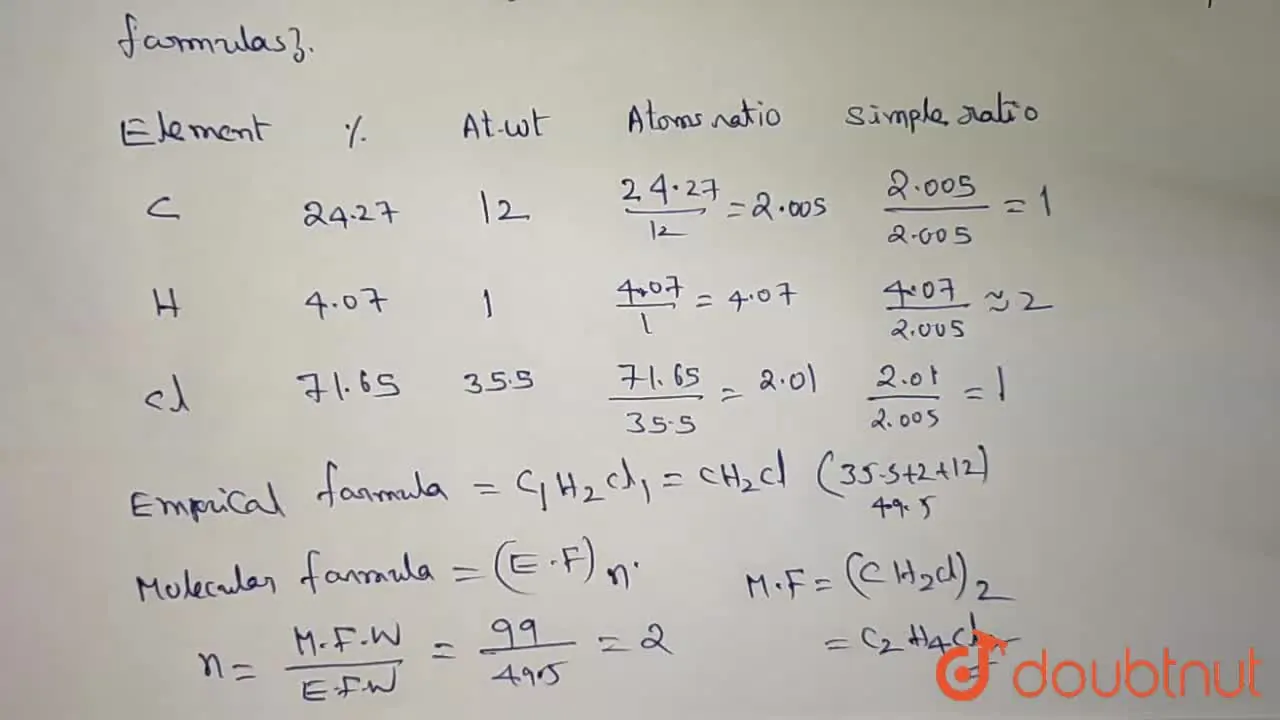A compound contains 4.07% hydrogen, 24.27% carbon and 71.65% chlorine. Its molar mass is 98.96 g. What are its empirical and molecular formulas ? Solution in Telugu
Since we are having mass percent, it is converient to use ,100 g of the compound as the starting material. Thus, in the 100 g. Sample of the above compound, 4.07 g hy-drogen, 24.27 g carbon, and 71.65 g chlo-rine are present.
Stap 2. Convertion into number of moles of each element:
Divide the masses obtained above by re-spective atomic masses of various elements.
Moles of hydrogen= 4.07g1.008gmol−1=4.04
Moles of carbon = 24.27g1.2.0lgmol−1=2.021
Moles of chlorine = 71.65g35.453gmol−1=2.021
Step 3. Divide the mole value obtained above by the smallest number :
Since 2.021 is smallest value, division by it gives a ratio of 2:1:1 for H:C:Cl. in case the ratios are not whole numbers, then they may be converted into whole num-ber by multiplying by the suitable coefficient.
Step 4. These mumbers indicate the rela-tive number of atoms of the elements. Write empirical formula by mentioning the numbers after writing the symbols of re-spective elements :
CH2Cl is thus, the empirical formula of the above compound.
Step 5. Writing molecular formula :
(a) Determine empirical formula mass. Add the atomic masses of various atoms present in the empirical formula.
For CH2Cl empirical formula mass is12.01+2×1.008+35,453=49.48g<br>(b)DivMolarmassbyemπricalforμlamass<br>=("Molar mass of the compound ")/("Empirical formula mass " )=(98.96 g)/(49.48 g)=2=(n)<br>(C)Mt–iplyemπricalforμlabynobta∈edabove→≥tthemo≤ca––rforμla.<br>Emπricalforμla=CH_(2)Cl.n=2.Hencemo≤ca––rforμlaisC_(2)H_(4)Cl_(2)
Related Playlists
- BOOK - VIKRAM PUBLICATION ( ANDHRA PUBLICATION)CHAPTER - STOICHIOMETRY EXERCISE - VERY SHORT Answer questions13videos
STOICHIOMETRY
- BOOK - VIKRAM PUBLICATION ( ANDHRA PUBLICATION)CHAPTER - STOICHIOMETRY EXERCISE - SHORT ANSWER QUESTIONS88videos
STOICHIOMETRY
- BOOK - VIKRAM PUBLICATION ( ANDHRA PUBLICATION)CHAPTER - STATES OF MATTER GASES AND LIQUIDS EXERCISE - LONG ANSWER QUESTIONS22videos
STATES OF MATTER GASES AND LIQUIDS
- BOOK - VIKRAM PUBLICATION ( ANDHRA PUBLICATION)CHAPTER - THE P-BLOCK ELEMENTS GROUP-13EXERCISE - Long Answer Questions3videos
THE P-BLOCK ELEMENTS GROUP-13
Similar Questions
How many number of moles of glucose are present in 540 gms of glucose ?
05:29View SolutionThe approximate production of sodium carbonate per month is 424×106g. While that of methyl alcohol is 320×106 gm. Which is produced more in terms of moles ?
03:38View SolutionWrite notes on Intermolecular forces
04:16View SolutionHow are borax and boric acid prepared ? Explain the action of heat on them.
03:38View SolutionA compound contains 4.07% H, 24.27% C , and 71.65% Cl . If its molar mass is 98.96 , the molecular formula will be
02:36View SolutionA compound contains 4.07% hydrogen, 24.27% carbon and 71.65% chlorine. Its molar mass is 98.96g . What are its emirical and molecular formulas?
06:09View SolutionA compound contains 4.07% hydrogen, 24.27% carbon and 71.65% chlorine. Its molar mass is 98.96 g. What are its empirical and molecular formulas ?
03:51View SolutionA compound contains 4.07% hydrogen, 24.27% carbon and 71.65% chlorine. Its molar mass is 98.96 g. What are its empirical and molecular formulas?
07:13View SolutionA compound contains 4.07% hydrogen, 24.27% Carbon and 71.65%, Chlorine. Its molar mass is 98.96. Calculate is Empiricla and Molecular formulae.
06:50View SolutionA compound contains 4.07 % hydrogen, 24.27% carbon and 71.65% chlorine. Its molecular mass is 98.96. What are its empirical and molecular formulae ?
06:24View SolutionA compound contains 4.07%H,.24.27%C, and 71.65%Cl. If its molar mass is 98.96, the molecular formula will be
View SolutionA compound contains 4.07% hydrogen, 21.27% carbon and 71.65% chlorine. Its molar mass is 98.96g. What are its empirical and molecular formulas ?
View SolutionA compound contains 4.07% of hydrogen, 24.27% of carbon and 71.65% of chlorine. The molar mass is 98.96. What is the empirical and molecular formula?
06:01View SolutionIf the mass percent of the various elements of a compound is known, its empirical formula can be calculate. A compound contains 4.07% hydrogen, 24.27% carbon and 71.65% chlorine. Its molecular mass is 98.96. What are the empirical and molecular formulae?
05:30View SolutionA compound contains 4.07% hydrogen, 24.27% carbon and 71.65% chlorine. Its molar mass is 98.96g. What are its empirical and molecular formulas ?
03:59View Solution


